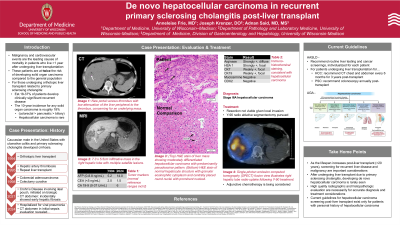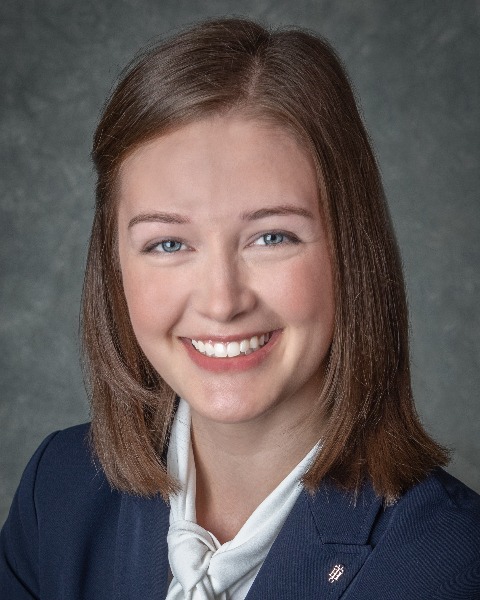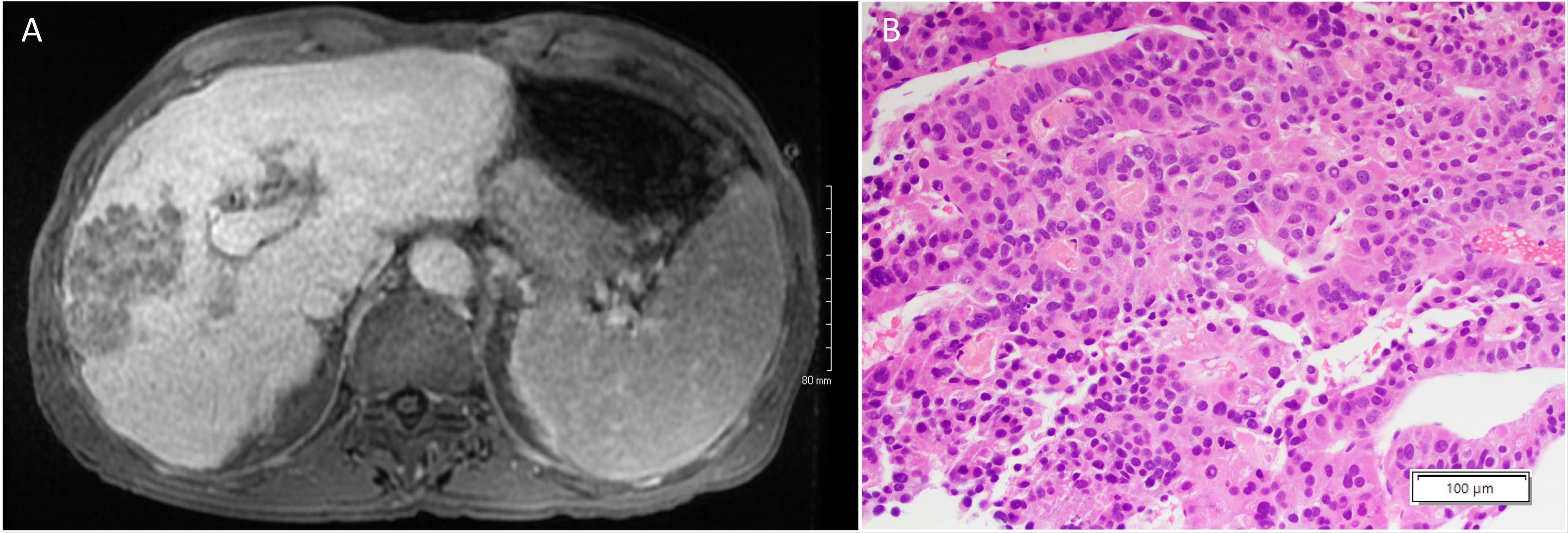Sunday Poster Session
Category: Liver
P1358 - De Novo Hepatocellular Carcinoma in Recurrent Primary Sclerosing Cholangitis Post-Liver Transplant
Sunday, October 27, 2024
3:30 PM - 7:00 PM ET
Location: Exhibit Hall E

Has Audio

Anneleise E. Frie, MD
University of Wisconsin Hospitals and Clinics
Madison, WI
Presenting Author(s)
Anneleise E. Frie, MD, Joseph Krenzer, DO, Adnan Said, MD, MS
University of Wisconsin Hospitals and Clinics, Madison, WI
Introduction: While primary sclerosing cholangitis recurrence and development of de novo cancer are not uncommon post-liver transplant (predominantly colorectal cancer and less commonly cholangiocarcinoma), developing de novo hepatocellular carcinoma post-liver transplant is exceedingly rare. We present an exceptional case of recurrent primary sclerosis cholangitis and de novo hepatocellular carcinoma 29 years post-orthotopic liver transplant.
Case Description/Methods: A 42-year old Caucasian male with ulcerative colitis in the United States received an orthotopic liver transplant in 1994 for primary sclerosing cholangitis. His post-transplant course was complicated by hepatic artery thrombosis, so he received a second orthotopic liver transplant in 1995. He developed mucinous colorectal adenocarcinoma post-transplant and underwent curative total colectomy in 1998. While admitted for diarrhea due to newly diagnosed Crohn’s Disease in 2021, abdominal computerized tomography showed evidence of recurrent primary sclerosing cholangitis. While hospitalized for viral pneumonia and abdominal pain nearly 29 years post-transplant in 2024 abdominal computerized tomography revealed cirrhotic liver morphology and a new hepatic mass. Magnetic resonance imaging confirmed a bulky mass in the right hepatic lobe with multiple satellite lesions and histopathology from biopsies of the mass characterized moderately differentiated hepatocellular carcinoma (Image 1). The patient was diagnosed with stage IIIA hepatocellular carcinoma, discussed at multidisciplinary tumor conference, and Y-90 radio ablative segmentectomy with possible adjunctive chemotherapy treatments are planned.
Discussion: In patients undergoing liver transplant for hepatocellular carcinoma, screening for recurrent cancer has been shown to have significant mortality benefit and most cases of liver cancer occur within five years post-transplant. Development of de novo hepatocellular carcinoma after liver transplant is rare, but as transplant longevity increases post-liver transplant screening for recurrent liver disease (PSC, cirrhosis) and malignancy are important considerations. This case exemplifies how such screenings could be beneficial and the importance of using high-quality imaging and histopathology for accurate diagnosis and treatment guidance.

Disclosures:
Anneleise E. Frie, MD, Joseph Krenzer, DO, Adnan Said, MD, MS. P1358 - De Novo Hepatocellular Carcinoma in Recurrent Primary Sclerosing Cholangitis Post-Liver Transplant, ACG 2024 Annual Scientific Meeting Abstracts. Philadelphia, PA: American College of Gastroenterology.
University of Wisconsin Hospitals and Clinics, Madison, WI
Introduction: While primary sclerosing cholangitis recurrence and development of de novo cancer are not uncommon post-liver transplant (predominantly colorectal cancer and less commonly cholangiocarcinoma), developing de novo hepatocellular carcinoma post-liver transplant is exceedingly rare. We present an exceptional case of recurrent primary sclerosis cholangitis and de novo hepatocellular carcinoma 29 years post-orthotopic liver transplant.
Case Description/Methods: A 42-year old Caucasian male with ulcerative colitis in the United States received an orthotopic liver transplant in 1994 for primary sclerosing cholangitis. His post-transplant course was complicated by hepatic artery thrombosis, so he received a second orthotopic liver transplant in 1995. He developed mucinous colorectal adenocarcinoma post-transplant and underwent curative total colectomy in 1998. While admitted for diarrhea due to newly diagnosed Crohn’s Disease in 2021, abdominal computerized tomography showed evidence of recurrent primary sclerosing cholangitis. While hospitalized for viral pneumonia and abdominal pain nearly 29 years post-transplant in 2024 abdominal computerized tomography revealed cirrhotic liver morphology and a new hepatic mass. Magnetic resonance imaging confirmed a bulky mass in the right hepatic lobe with multiple satellite lesions and histopathology from biopsies of the mass characterized moderately differentiated hepatocellular carcinoma (Image 1). The patient was diagnosed with stage IIIA hepatocellular carcinoma, discussed at multidisciplinary tumor conference, and Y-90 radio ablative segmentectomy with possible adjunctive chemotherapy treatments are planned.
Discussion: In patients undergoing liver transplant for hepatocellular carcinoma, screening for recurrent cancer has been shown to have significant mortality benefit and most cases of liver cancer occur within five years post-transplant. Development of de novo hepatocellular carcinoma after liver transplant is rare, but as transplant longevity increases post-liver transplant screening for recurrent liver disease (PSC, cirrhosis) and malignancy are important considerations. This case exemplifies how such screenings could be beneficial and the importance of using high-quality imaging and histopathology for accurate diagnosis and treatment guidance.

Figure: Image 1: (A) T1 weighted axial magnetic resonance imaging of abdomen with contrast at 5 minutes that illustrates a bulky and infiltrative 7.3 x 5.5 cm mass, located in the right hepatic lobe with associated non-occlusive right anterior portal vein thrombi and surrounding satellite lesions. (B) Hematoxylin and eosin (H&E) stain of liver mass biopsy obtained via interventional radiologic guidance that shows moderately differentiated hepatocellular carcinoma with predominant pseudo acinar pattern.
Disclosures:
Anneleise Frie indicated no relevant financial relationships.
Joseph Krenzer indicated no relevant financial relationships.
Adnan Said indicated no relevant financial relationships.
Anneleise E. Frie, MD, Joseph Krenzer, DO, Adnan Said, MD, MS. P1358 - De Novo Hepatocellular Carcinoma in Recurrent Primary Sclerosing Cholangitis Post-Liver Transplant, ACG 2024 Annual Scientific Meeting Abstracts. Philadelphia, PA: American College of Gastroenterology.
